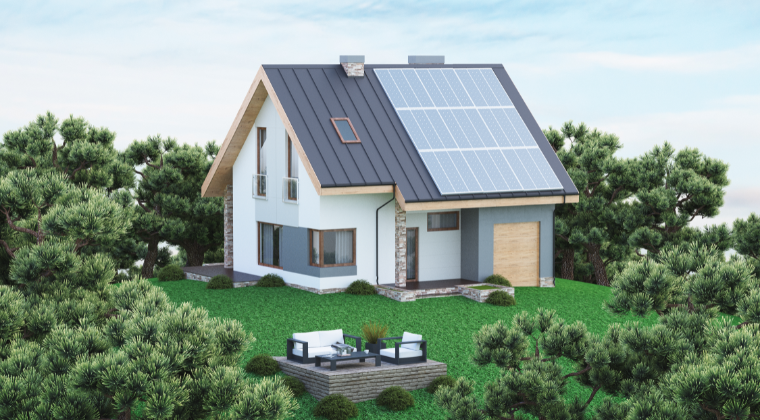Climate change is not only a global concern: it also directly affects the Swiss real estate market. Many properties in turn risk losing value or becoming more difficult to inhabit. In Switzerland, the main challenges concern extreme weather phenomena: floods, heatwaves and storms.
1. Danger of water: floods
Floods can have several causes: heavy rains, storms or rising water levels. Extreme precipitation is becoming more frequent and intense. In Switzerland, by 2030, one third of basements could be exposed to floods, and nearly half by 2050. The amount of rain falling in just ten minutes has already increased by 20% over the past forty years.
When the water no longer infiltrates the ground nor flows through the pipes, it accumulates on the surface and floods cellars and underground garages. The damage can be considerable, ranging from soaked walls to destroyed furniture. In the most serious situations, the water backs up through the pipes and enters directly into homes through toilets or sinks.
Frequent damages:
- damaged floors,
- damaged walls,
- soaked furniture,
- development of mold.
These risks require adaptation measures: strengthening the sealing of openings, improving the insulation of cellar doors and windows, or arranging the outdoor areas to facilitate water drainage.
Consequences: properties located near watercourses or in regions exposed to heavy precipitation could see their value decreas
2. Rise in temperatures
Heatwaves constitute the second major threat of global warming for the real estate market. By the end of the century, almost all Swiss buildings could suffer damage related to heatwaves. The most exposed areas are Geneva, Lausanne, Basel and Mendrisio.
Negative consequences on buildings:
- cracks on roofs and walls,
- materials that swell or deform,
- ventilation systems more energy-consuming and less effective,
- possible subsidence of groundwater tables.
Health risks for inhabitants:
- deterioration of sleep quality,
- increase of mortality during heatwaves.
The potential impact of global warming on the real estate sector
- Devaluation of exposed properties: poorly insulated dwellings, located in flood-prone areas or subject to recurring heatwaves, could lose value.
- Internal climate migration: certain areas will become less attractive (Rhône plain, southern Ticino), while others could gain value (mid-altitude zones, more temperate regions). This could create new real estate hotspots.
- Restricted access to credit: banks could limit or make more expensive the financing for properties considered at climate risk, reducing the liquidity of this market segment.
- Green taxes or incentives: this could translate into subsidies promoting energy renovation, but also into the introduction of taxes targeting buildings that are too energy-consuming or insufficiently adapted to the new climate conditions.
- Increase in demand for “resistant” housing: potential increase in demand for properties with good natural ventilation, shaded spaces, integration of vegetation, and the use of materials capable of resisting bad weather and heatwaves.
- Offices and commercial spaces: with the multiplication of heatwaves, the climatic comfort of workplaces becomes a determining criterion. Well-insulated spaces, efficiently ventilated and designed to limit the impact of extreme temperatures, may see their demand increase.
- Secondary residences: some leisure properties could lose their appeal (too exposed areas), others on the contrary gain it (altitude, cool zones).
The value of the property will no longer depend solely on its condition and its location but also on its climate risk profile as assessed by banks and insurers.
Proactive action for real estate investors
- Risk assessment: it is important to identify and analyze the risks linked to climate change. This can be done with the support of a climate expert, in order to carefully examine the areas exposed to floods, heatwaves or landslides before any investment.
- Sustainable construction: investing in sustainable construction practices makes it possible to reduce energy consumption and increase resilience to extreme climate phenomena. This involves energy-efficient, well-insulated and weather-resistant buildings.
- Diversification: it is recommended to diversify one’s real estate portfolio in order to better spread the risks linked to climate. This can be done through investments in different geographical regions or in several types of properties.
- Focus on communication centered on sustainability: with the rise of climate risks, highlighting the ecological qualities and resilience of a property can become an asset to promote the sale and rental of the property.
Role of urban planning: areas with potential vs. areas in decline
Climate change will profoundly modify the map of regional attractiveness in Switzerland. Certain areas will lose value, such as the Rhône plain, southern Ticino or certain parts of the Plateau, exposed to heatwaves, landslides and heavy precipitation. Conversely, mid-altitude or temperate regions (Prealps, Jura, upper Valais) could become climate refuges, reinforcing their residential and touristic attractiveness.
For investors and developers, this implies that the future real estate hotspots will not necessarily be located in the zones of strong current demand, but in those offering better long-term climate resilience.
Conclusions
In the coming decades, a growing share of Swiss dwellings could become difficult to inhabit due to climate change. Yet, this context also opens new opportunities for real estate professionals:
- Advice and valorization: climate expertise becomes a sales argument, through resilience diagnostics, energy labels or green certifications.
- New markets: the rise of sustainable real estate projects (eco-districts, passive residences) and the reinforced attractiveness of mountainous or temperate regions, better protected against extreme heat.
- Massive renovation: a significant potential for companies specialized in energy renovation and climate adaptation, with a demand that will probably only increase.
